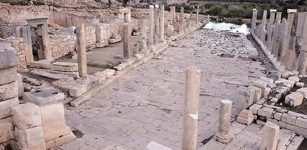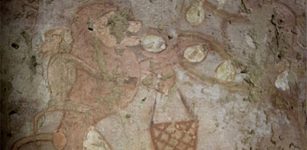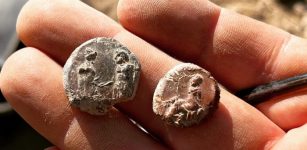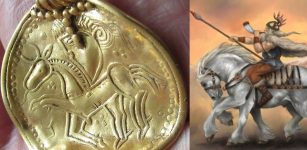Numa Pompilius – Remarkable Legendary Second King Of Ancient Rome Who Succeeded Romulus – Did He Ever Exist?
A. Sutherland - AncientPages.com - Legends say Numa Pompilius was the second king of Rome, but he was not a warrior king but a statesman and politician.
Numa introduced new laws, customs, cults, and holidays during his reign. In contrast to the times of King Romulus and the city of Rome's involvement in wars, the ruler Numa Pompilius wanted Rome to experience quieter times.
But How Did Numa Pompilius Come To Power?
As the legend says, after the death of the legendary Romulus, there was a long, tiring dispute on the next succession to the throne. Finally, Pompilius (known for purity and wisdom) was chosen and agreed upon; however, he had to ask the gods first. The fortune-tellers were successful, and Numa put on royal robes.
The new ruler began with changes regarding religion and claimed that these changes had to occur because Egeria (a mythological water nymph who was his wife and counselor) had ordered him to do it.
Such alleged connections with the supernatural forces had raised Numa's authority and prestige.
Did Numa Pompilius Really Exist?
It is uncertain whether this fascinating figure really existed. There are only legends about his life but no actual historical facts. According to ancient tradition, he belonged to the Sabines (an Italic tribe from the central Apennines) and was born on the day Rome was founded (753 BC). He ruled from 715 BC until he died in 672 BC. He was about 40 years old at the time he took power.
Numa Pompilius at the Louvre, by Jean Guillaume Moitte. Image credit: Marie-Lan Nguyen - Public Domain
Numa created various offices and authorities for civic workers and came up with January, February, and a calendar system that influenced our modern calendar. He also adjusted the solar and lunar years.
The 10-month year had been replaced by a year divided into 12 lunar months. It counted 354 days; every 19 years, there were leap months.
Unfortunately, there is not much information about this calendar. In addition, the king made a list of successful days (dies fasti) and unfavorable days (dies nefasti). On unfortunate days, conducting court hearings or convening a gathering of citizens was optional.
According to Plutarch (46 AD – 120 AD), Numa was a wise and religious man who ordered the construction of a temple dedicated to Janus in Rome. Janus was the two-faced god of boundaries, and his temple was not ordinary. Its doors (the "Gates of Janus") were closed in times of peace and opened in times of war.
Egeria Gives the Laws of Rome to Numa Pompilius, Anna Ottani Cavina, Spanish Embassy to the Holy See, Rome, 1806.
For three great deities of Rome, Jupiter, Mars, and Quirinus (Quirinus is the name under which Romulus was worshiped), Pompilius introduced special priests. He brought Vestal Virgins (priestesses of Vesta, goddess of the hearth) to Rome. The Vestals were freed of the usual social obligations to marry and bear children. They took a vow of chastity to devote themselves to the study and correct observance of state rituals that were off-limits to the male colleges of priests.
Numa was said to have authored several "sacred books" containing divine teachings, mostly from Egeria and the Muses.
However, Numa Pompilius could not be a Pythagorean student – as referred by Plutarch and a Roman historian Livy, because an Ionian Greek philosopher, Pythagoras, was born 100 years later, c. 570 BC.
On the other hand, the second king of Rome died in 672 BC, if we believe the legends and myths surrounding the second king of Rome.
If he had existed, he probably could not have contributed to many significant achievements and carried out all new reforms in his city of Rome.
If he did (Numa ruled for 43 years), he was indeed a remarkable Roman leader. However, many believe that all-important changes in Roman religion and the peoples' customs took a long time and differed from one individual's work.
Written by A. Sutherland – AncientPages.com Staff Writer
Updated on January 13, 2024
Copyright © AncientPages.com All rights reserved. This material may not be published, broadcast, rewritten or redistributed in whole or part without the express written permission of AncientPages.com
Expand for referencesMore From Ancient Pages
-
 Glorious And Scary Orava Castle – Realms Of Nosferatu And A Historical Landmark Of Slovakia
Featured Stories | Jan 24, 2020
Glorious And Scary Orava Castle – Realms Of Nosferatu And A Historical Landmark Of Slovakia
Featured Stories | Jan 24, 2020 -
 Mysterious Location Of The Amazing Land Of Punt – Can This Puzzle Be Solved One Day?
Featured Stories | Jul 18, 2016
Mysterious Location Of The Amazing Land Of Punt – Can This Puzzle Be Solved One Day?
Featured Stories | Jul 18, 2016 -
![Photo taken on Dec 20, 2015 shows hoof-shaped gold ware unearthed from the main coffin in the Haihunhou (Marquis of Haihun) cemetery, East China's Jiangxi province. [Photo/Xinhua]](https://www.ancientpages.com/wp-content/uploads/2015/12/MarquisofHaihuntomb1-307x150.jpg) Does A 2,000-Year-Old Tomb Belong To Marquis of Haihun? – Search For His Seal Continues
Archaeology | Dec 25, 2015
Does A 2,000-Year-Old Tomb Belong To Marquis of Haihun? – Search For His Seal Continues
Archaeology | Dec 25, 2015 -
 Does A Baffling Artifact Offer Evidence Of Ancient Extraterrestrial Visitation In New Zealand? – Experts Investigate – Part 2
Featured Stories | Jul 23, 2020
Does A Baffling Artifact Offer Evidence Of Ancient Extraterrestrial Visitation In New Zealand? – Experts Investigate – Part 2
Featured Stories | Jul 23, 2020 -
 Patara: One Of The Six Big Cities Of Lycian League Is Celebrated In 2020
Archaeology | Jan 15, 2020
Patara: One Of The Six Big Cities Of Lycian League Is Celebrated In 2020
Archaeology | Jan 15, 2020 -
 ‘Euros Of Prehistory’ Were Currency Of People From The Early Bronze Age Of Central Europe
Artifacts | Jan 21, 2021
‘Euros Of Prehistory’ Were Currency Of People From The Early Bronze Age Of Central Europe
Artifacts | Jan 21, 2021 -
 Tomb Of Hathor’s Priestess Hetpet Unearthed Near Pyramid Of Khafre, Cairo, Egypt
Archaeology | Feb 5, 2018
Tomb Of Hathor’s Priestess Hetpet Unearthed Near Pyramid Of Khafre, Cairo, Egypt
Archaeology | Feb 5, 2018 -
 Mystery Of King Solomon’s Mines: An Unsolved Ancient Enigma
Featured Stories | Aug 9, 2018
Mystery Of King Solomon’s Mines: An Unsolved Ancient Enigma
Featured Stories | Aug 9, 2018 -
 Mysterious Footprints In Tanzania Made By Early Humans Not Bears
Archaeology | Dec 1, 2021
Mysterious Footprints In Tanzania Made By Early Humans Not Bears
Archaeology | Dec 1, 2021 -
 Disappearance Of The El Argar Civilization – Why Has No One Lived In The La Almoloya Region Again?
Civilizations | May 10, 2022
Disappearance Of The El Argar Civilization – Why Has No One Lived In The La Almoloya Region Again?
Civilizations | May 10, 2022 -
 Hidden Role Of The Milky Way And Egyptian Goddess Nut Examined
Myths & Legends | Apr 15, 2024
Hidden Role Of The Milky Way And Egyptian Goddess Nut Examined
Myths & Legends | Apr 15, 2024 -
 Hayk – Legendary Patriarch And Founder Of Armenia Who Defeated King Bel Of Babylon
Featured Stories | Feb 10, 2022
Hayk – Legendary Patriarch And Founder Of Armenia Who Defeated King Bel Of Babylon
Featured Stories | Feb 10, 2022 -
 The Boomerang Was Used 20,000 Years Ago By Stone Age People
Ancient History Facts | Sep 28, 2018
The Boomerang Was Used 20,000 Years Ago By Stone Age People
Ancient History Facts | Sep 28, 2018 -
 The Eagle And The Condor Prophecy: A 2,000-Year-Old Message For The Future
Featured Stories | Apr 21, 2017
The Eagle And The Condor Prophecy: A 2,000-Year-Old Message For The Future
Featured Stories | Apr 21, 2017 -
 Ancient Maya Saltworks: Salt Was A Commodity Or Money In Classic Maya Economy
Archaeology | Mar 23, 2021
Ancient Maya Saltworks: Salt Was A Commodity Or Money In Classic Maya Economy
Archaeology | Mar 23, 2021 -
 Melipona Beecheii – Sacred Ancient Maya Beekeeping Site Discovered In Quintana Roo, Mexico
Archaeology | May 28, 2024
Melipona Beecheii – Sacred Ancient Maya Beekeeping Site Discovered In Quintana Roo, Mexico
Archaeology | May 28, 2024 -
 Traces Of Ancient Maya In Europe? Controversial Theory Examined
Civilizations | May 25, 2018
Traces Of Ancient Maya In Europe? Controversial Theory Examined
Civilizations | May 25, 2018 -
 More Than 2,000 Seal Impressions Found In The Ancient City Of Doliche
Archaeology | Nov 24, 2023
More Than 2,000 Seal Impressions Found In The Ancient City Of Doliche
Archaeology | Nov 24, 2023 -
 Discovered Gold Pendant Of Odin And His Horse Sleipnir Might Be Linked To The Heruli Tribe
Archaeology | Apr 16, 2016
Discovered Gold Pendant Of Odin And His Horse Sleipnir Might Be Linked To The Heruli Tribe
Archaeology | Apr 16, 2016 -
 On This Day In History: ‘Diamond Sutra’ The Oldest Dated, Printed Book Is Published – On May 11, 868
News | May 11, 2016
On This Day In History: ‘Diamond Sutra’ The Oldest Dated, Printed Book Is Published – On May 11, 868
News | May 11, 2016



